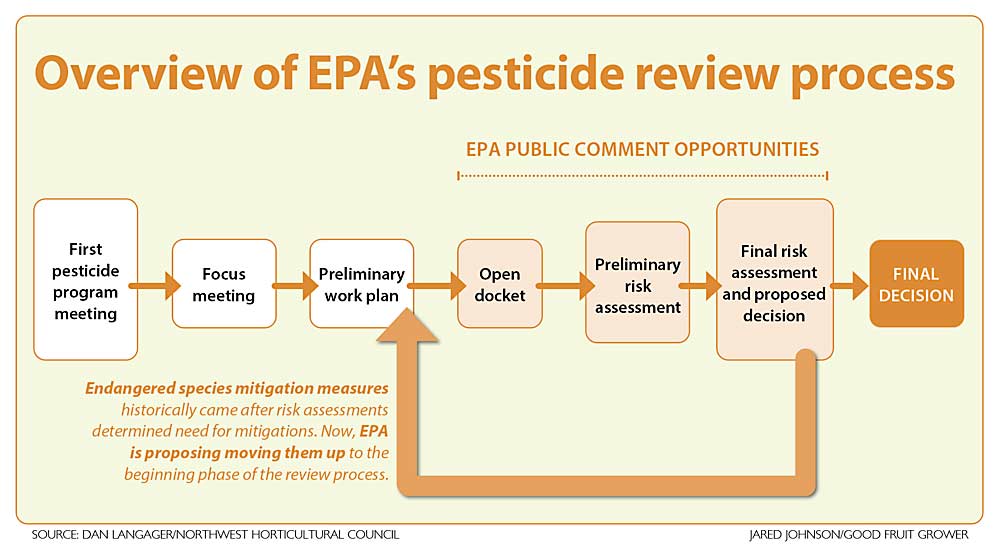
Significant challenges lie ahead for growers when the U.S. Environmental Protection Agency (EPA) finalizes proposed changes affecting the use of pesticides.
In its attempt to shift how it addresses the Endangered Species Act (ESA), EPA is proposing to incorporate certain ecological mitigation measures as a condition of registration for new conventional pesticides and as part of registration reviews. The idea is that these mitigation measures will help reduce potential pesticide exposure to nontarget wildlife, including endangered and threatened species.
The EPA has been taken to court numerous times by advocacy groups for allegedly failing to comply with the ESA and wants to avoid a growing number of lawsuits and ensuing court decisions that jeopardize its pesticide registration decisions. “Existing court-enforceable deadlines, combined with ongoing litigation and settlement discussions, will require EPA to complete ESA reviews for over 50 pesticides, thus filling the agency’s ESA workload well beyond 2030,” according to the agency.

In response to the lawsuits, EPA is proposing to include wildlife protections at the beginning of its Federal Insecticide, Fungicide, and Rodenticide Act-mandated pesticide safety-review process, rather than waiting until focused ESA risk assessments are conducted (see graphic). The EPA’s new ESA work plan proposes extensive measures designed to reduce the potential for spray drift and pesticide runoff, such as no-spray buffer zones, water retention ponds and vegetative ditches. Under this approach, many specialty crop growers’ pesticide programs will likely be required to include one or more mitigations offered by EPA as part of their options to prevent potential effects on nontarget wildlife.
Additionally, pesticide applicators will be required to use an EPA online website tool — “Bulletins Live! Two” — whenever a pesticide label directs endangered species limitations on a product’s use, intended application area and application month. Applicators will become legally responsible for checking the website within six months of the day of application and following any listed ESA-related restrictions. In short, these restrictions will be part of the pesticide’s label.
Many within the specialty crop community are concerned EPA’s proposals could limit growers’ continued access to important crop protection chemicals. The Northwest Horticultural Council (NHC), which represents growers, packers and shippers of apples, pears and cherries in the Pacific Northwest, worked with the Minor Crop Farmer Alliance (MCFA) to provide extensive comments on EPA’s proposed work plan. MCFA told EPA that federal agencies are using inaccurate estimates of pesticide use to make ESA decisions, setting a path to significantly curtail growers’ pesticide access without making endangered species any safer.
The new work plan is a 180-degree change in the agency’s current FIFRA policy, replacing a methodical, slow approach with an “act now, ask questions later” policy, said Jim Cranney, MCFA chair, in an MCFA press release. “MCFA is sympathetic to EPA’s dilemma, but the proposed policy presents potential difficulties that growers may have to address if they want to use pesticides,” he said.
David Epstein, NHC’s vice president of scientific affairs and MCFA’s vice chair, said EPA’s proposed mitigation measures are better suited for major field crops rather than specialty crop production. For the ecological mitigations that are applicable for orchardists, such as using riparian strips to prevent runoff into rivers, EPA has not adequately considered the impacts on growers’ operations. Establishing and maintaining certain mitigation practices will be costly, and there are limited relationships among specialty crop growers and experts at USDA’s Natural Resources Conservation Service or land grant universities currently consulting on these questions.
Epstein said some of EPA’s proposed measures would require wholesale changes to the established cropping systems of perennial fruit tree orchards, thereby increasing the costs for growers to use affected pesticides. Orchardists and other specialty crop growers generally have much smaller farms than major crop producers, and therefore have less flexibility in absorbing mitigation-related reductions in production acreage and yield.
Another concern with several of the proposed EPA mitigations directly addresses growers’ food safety efforts. Specialty crop producers must already meet extensive food safety requirements, including preventing product contamination by microbial and other pathogens. “Some of EPA’s proposed mitigations could create an environment that attracts animals, amphibians and reptiles into fields, a cause for concern for growers and the public alike,” MCFA’s Cranney said.
MCFA and NHC will strongly emphasize the need for EPA to work with the agricultural community to develop mitigation measures appropriate for specialty crop producers. Epstein said growers are for protecting threatened and endangered species and their habitats, but proposed mitigation practices should allow growers to play their roles in conservation while still safely and economically producing the nation’s food.
NHC will work with its members and industry crop consultants to assist tree fruit growers on strategies to meet EPA’s new requirements, including navigating and implementing Bulletins Live! Two. Epstein said it is incumbent on EPA to provide outreach and training opportunities so that growers will be best informed and able to know when and where certain pesticides and endangered species combinations will have label limitations.
“These proposed measures are all pervasive in how they will impact growers’ management programs,” Epstein said. “It’s important that growers see what’s coming and prepare.”
by Dan Langager
Dan Langager is the technical communications manager of the Northwest Horticultural Council. Based in Yakima, Washington, the NHC represents the growers, packers and shippers of apples, pears and cherries in Washington, Oregon and Idaho on federal and international policy and regulatory issues.






Leave A Comment